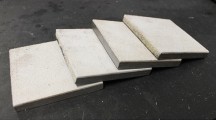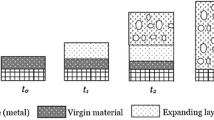Abstract
The standard fire resistance test failed to consider the effect of environmental wind on intumescent fire-retardant coatings. This study investigated the thermal insulation of intumescent fire-retardant coatings under various heating exposures (25 kW/m2, 35 kW/m2, 50 kW/m2 and 75 kW/m2) and wind speeds (0 m/s, 1 m/s, 2 m/s, 3 m/s). Fire-retardant coating presented a non-uniform intumescent process with wind influence. Environmental wind slowed the initial swelling rate, decreased the maximum coating thickness, and promoted the coating thickness decline. The coating at the front end was shorter than the rear end, which caused a higher steel temperature at the front end. The time of the steel temperature to reach the critical temperature was advanced indicating a decreased thermal insulation. Environmental wind caused a higher coating temperature and accelerated the coating depletion at the front end. The influence is stronger with higher heating exposure and faster wind speed. Wind affects the coating temperature and coating thickness via convective cooling and char oxidation, and char oxidation is a more dominant factor. Empirical correlations were applied to represent the influence of environmental wind on the maximum swelled thicknesses and average swelling rates of fire-retardant coatings at the front end. The predicting equation indicated the synergistic effects of wind speed and incident heat flux on the thermal insulation of fire-retardant coating.













Similar content being viewed by others
References
Silva D, Bilotta A, Nigro E (2019) Experimental investigation on steel elements protected with intumescent coating. Constr Build Mater. https://doi.org/10.1016/j.conbuildmat
Yan L, Xu Z, Liu D (2019) Synthesis and application of novel magnesium phosphate ester flame retardants for transparent intumescent fire-retardant coatings applied on wood substrates. Prog Org Coat. https://doi.org/10.1016/j.porgcoat.2019.01.013
Usmani AS, Rotter JM, Lamont S et al (2001) Fundamental principles of structural behaviour under thermal effects. Fire Saf J. https://doi.org/10.1016/S0379-7112(01)00037-6
GB51249-2017 (2018) Code for fire safety of steel structures in buildings. National Standardization Administration of China
GB14907-2018 (2018) Fire resistive coating for steel structure. National Standardization Administration of China
Lucherini A, Maluk C (2019) Intumescent coatings used for the fire-safe design of steel structures: a review. J Constr Steel Res. https://doi.org/10.1016/j.jcsr.2019.105712
Staggs JEJ, Crewe RJ, Butler R (2012) A theoretical and experimental investigation of intumescent behaviour in protective coatings for structural steel. Chem Eng Sci. https://doi.org/10.1016/j.ces.2011.12.010
Lucherini A, Lam HY, Jimenez M (2022) Fire testing of intumescent coatings: comparison between bench-scale furnace and radiant panels experimental methodologies. Fire Technol. https://doi.org/10.1007/s10694-022-01216-3
Lucherini A, Razzaque QS, Maluk C (2019) Exploring the fire behaviour of thin intumescent coatings used on timber. Fire Saf J. https://doi.org/10.1016/j.firesaf.2019.102887
Lucherini A, Hidalgo JP, Torero JL, Maluk C (2021) Influence of heating conditions and initial thickness on the effectiveness of thin intumescent coatings. Fire Saf J. https://doi.org/10.1016/j.firesaf.2020.103078
ISO 834-1 (1999) Fire resistance tests—elements of building construction—part 1: general requirements for fire resistance testing. International Organization for Standardization (ISO), Geneva
EN 13381-13388 (2013) Test methods for determining the contribution to the fire resistance of structural members—part 8: applied reactive protection to steel members brussels. Comité Europeén de Normalization (CEN)
GB 12441-2018 (2018) Finishing fire resistant. National Standardization Administration of China
Robertson A, Gross D (1970) Fire load, fire severity, and fire endurance. ASTM Int. https://doi.org/10.1520/STP44709S
Lucherini A, Giuliani L, Jomaas G (2018) Experimental study of the performance of intumescent coatings exposed to standard and non-standard fire conditions. Fire Saf J. https://doi.org/10.1016/j.firesaf.2017.10.004
Williams FA (1982) Urban and wildland fire phenomenology. Prog Energy Combust Sci. https://doi.org/10.1016/0360-1285(82)90004-1
Liu N, Lei J, Gao W et al (2021) Combustion dynamics of large-scale wildfires. Proc Combust Inst. https://doi.org/10.1016/j.proci.2020.11.006
Zhao W, Ouyang R, Ran Q et al (2021) An experimental study on smoke back-layering and critical velocity in tunnel fires with canyon cross wind. J Wind Eng Ind Aerodyn. https://doi.org/10.1016/j.jweia.2020.104477
Li M, Gao Z, Ji J et al (2017) Wind effects on flame projection probability from a compartment with opposing openings. Fire Saf J. https://doi.org/10.1016/j.firesaf.2017.04.037
Fang X, Ren F, Zhang X et al (2020) Facade flame height ejected from opening of a compartment under the coupling effect of side walls and ambient wind. Fire Saf J. https://doi.org/10.1016/j.firesaf.2020.102966
Hu L, Zhang X, Delichatsios MA et al (2017) Pool fire flame base drag behavior with cross flow in a sub-atmospheric pressure. Proc Combust Inst. https://doi.org/10.1016/j.proci.2016.06.139
Pitts WM (1991) Wind effects on fires. Prog Energy Combust Sci. https://doi.org/10.1016/0360-1285(91)90017-H
Węgrzyński W, Lipecki T (2018) Wind and fire coupled modelling—part I: literature review. Fire Technol. https://doi.org/10.1007/s10694-018-0748-5
Bai ZP, Li YF, Zhao YH (2019) Study on characteristics of fire plume in building facade window under lateral blow. PLoS ONE. https://doi.org/10.1371/journal.pone.0225120
Hu LH, Sun XP, Zhang XL et al (2018) Facade flame height and horizontal extending distance from opening of compartment fire with external sideward wind. Proc Combust Inst. https://doi.org/10.1016/j.proci.2018.06.2013
Ren F, Hu LH, Sun XP, Hu KZ (2018) An experimental study on vertical temperature profile of facade fire plume ejected from compartment with an opening subjected to external wind normal to façade. Int J Therm Sci. https://doi.org/10.1016/j.ijthermalsci.2018.04.008
Gao W, Liu NA, Delichatsios M et al (2016) Fire spill plume from a compartment with dual symmetric openings under cross wind. Combust Flame. https://doi.org/10.1016/j.combustflame.2016.01.011
Gomez-Mares M, Tugnoli A, Landucci G et al (2012) Behavior of intumescent epoxy resins in fireproofing applications. J Anal Appl Pyrolysis. https://doi.org/10.1016/j.jaap.2012.05.010
Bu R, Zhou Y, Shi L, Fan C (2021) Experimental study on combustion and flame spread characteristics in horizontal arrays of discrete fuels. Combust Flame. https://doi.org/10.1016/j.combustflame.2020.10.049
Bu R, Shi L, Zhou Y (2021) Identifying the criterion for discrete flame spread over single-row birch rods. Fire Saf J. https://doi.org/10.1016/j.firesaf.2020.103116
Naik AD, Duquesne S, Bourbigot S (2016) Hydrocarbon time-temperature curve under airjet perturbation: an in situ method to probe char stability and integrity in reactive fire protection coatings. J Fire Sci. https://doi.org/10.1177/0734904116658049
Jimenez M, Duquesne S, Bourbigot S (2006) Characterization of the performance of an intumescent fire protective coating. Surf Coat Technol. https://doi.org/10.1016/j.surfcoat.2006.01.026
Hu Y, Yang J, Baniotopoulos C et al (2020) Dynamic analysis of offshore steel wind turbine towers subjected to wind wave and current loading during construction. Ocean Eng. https://doi.org/10.1016/j.oceaneng.2020.108084
Li C, Liu Y, Li H (2021) Fragility assessment and optimum design of a steel-concrete frame structure with hybrid energy-dissipated devices under multi-hazards of earthquake and wind. Eng Struct. https://doi.org/10.1016/j.engstruct.2021.112878
Pieper L, Mahendran M (2022) Pull-through failure of crest-fixed steel claddings under combined wind and bushfire conditions. Thin-Walled Struct. https://doi.org/10.1016/j.tws.2022.109011
Fan CG, Li YH, Gao YX (2022) Effect of ambient wind on the flame retardancy of intumescent coatings. J Therm Anal Calorim. https://doi.org/10.1007/s10973-022-11593-0
Shen Y, Jiao A, Chen T et al (2021) Experimental study on smoke movement characteristics in tunnel fires with different canyon cross wind yaw angles. Tunn Undergr Space Technol. https://doi.org/10.1016/j.tust.2021.104129
Zhu YL, Zhang F, Xing LP et al (2022) Construction and verification of a heat transfer model for intumescent coatings. Prog Org Coat. https://doi.org/10.1016/j.porgcoat.2022.106868
Fateh T, Guillaume E, Joseph P (2017) An experimental study of the thermal performance of a novel intumescent fire protection coating. Fire Saf J. https://doi.org/10.1016/j.firesaf.2017.05.021
Juan PH, Tristan G, Vinny G (2019) The Malveira fire test: Full-scale demonstration of fire modes in open-plan compartments. Fire Saf J. https://doi.org/10.1016/j.firesaf.2019.102827
Zhang Y, Wang YC, Bailey CG, Taylor AP (2012) Global modelling of fire protection performance of intumescent coating under different cone calorimeter heating conditions. Fire Saf J. https://doi.org/10.1016/j.firesaf.2012.02.004
Lai D, Gong J, Zhou X et al (2021) Pyrolysis and piloted ignition of thermally thick PMMA exposed to constant thermal radiation in cross forced airflow. J Anal Appl Pyrolysis. https://doi.org/10.1016/j.jaap.2021.105042
Hu LH, Liu S, Wu L (2013) Flame radiation feedback to fuel surface in medium ethanol and heptane pool fires with cross air flow. Combust Flame. https://doi.org/10.1016/j.combustflame.2012.10.016
Wu TR, Zhou R, Zhang YP et al (2022) Spread behavior of spill fire under lateral wind and temperature distribution of PE sandwich panels on façade. Case Stud Constr Mater. https://doi.org/10.1016/j.cscm.2022.e01357
Ma YX, Hu LH, Huang YJ et al (2021) Effect of sample thickness on concurrent steady spread behavior of floor- and ceiling flames. Combust Flame. https://doi.org/10.1016/j.combustflame.2021.111600
Zhao K, Gollner MJ, Liu Q et al (2022) Lateral flame spread over PMMA under forced air flow. Fire Technol. https://doi.org/10.1007/s10694-019-00904-x
Climate and Average Weather Year Round in Changsha (China) (2016), Weather Spark. https://weatherspark.com/y/116088/Average-Weather-in-Changsha-China-Year-Round. Accessed 26 Aug 2022
Zhou YY, Walther DC, Fernandez-Pello AC (2002) Numerical analysis of piloted ignition of polymeric materials. Combust Flame. https://doi.org/10.1016/S0010-2180(02)00396-6
Lucherini A, Maluk C (2019) Assessing the onset of swelling for thin intumescent coatings under a range of heating conditions. Fire Saf J. https://doi.org/10.1016/j.firesaf.2019.03.014
Rich D, Lautenberger C, Torero JL et al (2007) Mass flux of combustible solids at piloted ignition. Proc Combust Inst Inst. https://doi.org/10.1016/j.proci.2006.08.055
Horrocks AR, Price D (2008) Advances in fire retardant materials. Woodhead Publishing Limited, Abington Hall
Acknowledgements
This work was financially supported by the High-Tech Industry Science and Technology Innovation Leading Plan of Hunan Province (No. 2020GK2079), Natural Science Foundation of Hunan Province (No. 2022JJ40618), Fundamental Research Funds for the Central Universities of Central South University (No. 2021zzts0767), and the Innovation Training Program for College Students of Central South University (No. 2022105330243)
Author information
Authors and Affiliations
Corresponding author
Ethics declarations
Conflict of interest
The authors declare that they have no known competing financial interests or personal relationships that could have appeared to influence the work reported in this paper.
Additional information
Publisher's Note
Springer Nature remains neutral with regard to jurisdictional claims in published maps and institutional affiliations.
Rights and permissions
Springer Nature or its licensor (e.g. a society or other partner) holds exclusive rights to this article under a publishing agreement with the author(s) or other rightsholder(s); author self-archiving of the accepted manuscript version of this article is solely governed by the terms of such publishing agreement and applicable law.
About this article
Cite this article
Li, Y., Fan, C., Gao, Y. et al. Influence of Wind Speeds and Heating Exposures on the Thermal Insulation of Intumescent Fire-Retardant Coatings. Fire Technol 59, 767–792 (2023). https://doi.org/10.1007/s10694-023-01366-y
Received:
Accepted:
Published:
Issue Date:
DOI: https://doi.org/10.1007/s10694-023-01366-y




